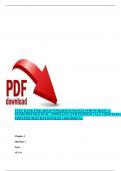TEST BANK FOR ADAM’S PHARMACOLOGY FOR NURSES: A
PATHOPHYSIOLOGIC APPROACH, |5TH EDITION | ALL CHAPTERS |
UPDATED 2024 | RATIONALES | GRADED A+
Chapter 1
Question 1
Type:
MCMA
,The nurse is teaching a pharmacology class to student nurses. What does the nurse include as
key events in the history of pharmacology?
Note: Credit will be given only if all correct choices and no incorrect choices are selected.
Standard Text: Select all that apply.
1. Initial drugs included morphine, cocaine, and penicillin.
2. Early researchers used themselves as test subjects.
3. The initial intention of pharmacology was to relieve human suffering.
4. Modern pharmacology began in the early 1600s.
5. Pharmacologists synthesized drugs in the laboratory in the twentieth century.
Correct Answer: 2,3,5
Rationale 1: Initial drugs isolated from complex mixtures included morphine,
colchicines, curare, and cocaine, but not penicillin.
Rationale 2: Some early researchers, such as Friedrich Serturner, used themselves as test
subjects.
Rationale 3: The early roots of pharmacology included the application of products to relieve
human suffering.
Rationale 4: Modern pharmacology began in the early 1800s, not the 1600s.
Rationale 5: By the twentieth century, pharmacologists could synthesize drugs in the
laboratory.
Global Rationale: The early roots of pharmacology included the application of products to
relieve human suffering, and early researchers used themselves as test subjects. Initial drugs
included morphine, colchicines, curare, and cocaine, but not penicillin. Modern pharmacology
began in the early 1800s, not the 1600s. By the twentieth century, pharmacologists could
synthesize drugs in the laboratory.
,Cognitive Level: Applying
Client Need: Physiological Integrity
Client Need Sub: Pharmacological and Parenteral Therapies
QSEN Competencies: I.A.1 Integrate understanding of multiple dimensions of patient centered
care: patient/family/community preferences, values; coordination and integration of care;
information, communication, and education; physical comfort and emotional support;
involvement of family and friends; and transition and community.
AACN Essential Competencies: I.7 Integrate the knowledge and methods of a variety
of disciplines to inform decision making.
NLN Competencies: Knowledge and Science: Integration of knowledge from nursing and
other disciplines.
Nursing/Integrated Concepts: Nursing Process: Implementation
Learning Outcome: 1-1 Identify key events in the history of pharmacology.
MNL Learning Outcome: 1.1.1 Apply basic concepts related to pharmacology.
Page Number: 3
Question 2
Type:
MCSA
The student nurse asks the nursing instructor why he needs to take anatomy and physiology, as
well as microbiology, when he only wants to learn about pharmacology. What is the best response
by the instructor?
1. "Because pharmacology is an outgrowth of those subjects."
2. "You must learn all, since those subjects, as well as pharmacology, are part of the
curriculum."
3. "Knowledge of all those subjects will prepare you to provide the best patient care, including
the administration of medications."
4. "Because an understanding of those subjects is essential to understanding pharmacology."
Correct Answer: 4
Rationale 1: Pharmacology is an outgrowth of anatomy, physiology, and microbiology, but this
is not the most complete reason for the nurse to learn them.
V
, Rationale V2: VThe Vnurse Vmust Vlearn Vanatomy, Vphysiology, Vand Vmicrobiology Vto Vunderstand
Vpharmacology, Vnot Vbecause Vthey Vare Vpart Vof Vthe Vcurriculum.
Rationale V3: VKnowledge Vof Vanatomy, Vphysiology, Vand Vmicrobiology Vprepares Vthe Vnurse Vto
Vunderstand Vpharmacology, Vnot Vto Vprovide Vcare Vsuch Vas Vadministration Vof Vmedications.
Rationale V4: VIt Vis Vessential Vfor Vthe Vnurse Vto Vhave Va Vbroad Vknowledge Vbase Vof Vmany
Vsciences Vin Vorder Vto Vlearn Vpharmacology.
Global VRationale: VIt Vis Vessential Vfor Vthe Vnurse Vto Vhave Va Vbroad Vknowledge Vbase Vof Vmany
Vsciences Vin Vorder Vto Vlearn Vpharmacology. VThe Vnurse Vmust Vlearn Vanatomy, Vphysiology, Vand
Vmicrobiology Vto Vunderstand Vpharmacology, Vnot Vbecause Vthey Vare Vpart Vof Vthe Vcurriculum.
VPharmacology Vis Van Voutgrowth Vof Vanatomy, Vphysiology, Vand Vmicrobiology, Vbut Vthis Vis Vnot
Vthe Vreason Vfor Vthe Vnurse Vto Vlearn Vthem. VKnowledge Vof Vanatomy, Vphysiology, Vand
Vmicrobiology Vprepares Vthe Vnurse Vto Vunderstand Vpharmacology, Vnot Vto Vprovide Vcare Vsuch Vas
Vadministration Vof Vmedications.
Cognitive VLevel: VApplying
Client VNeed: VPhysiological VIntegrity
Client VNeed VSub: VPharmacological Vand VParenteral VTherapies
QSEN VCompetencies: VI.A.1 VIntegrate Vunderstanding Vof Vmultiple Vdimensions Vof Vpatient
Vcentered Vcare: Vpatient/family/community Vpreferences, Vvalues; Vcoordination Vand Vintegration Vof
Vcare; Vinformation, Vcommunication, Vand Veducation; Vphysical Vcomfort Vand Vemotional Vsupport;
Vinvolvement Vof Vfamily Vand Vfriends; Vand Vtransition Vand Vcommunity.
AACN VEssential VCompetencies: VI.7 VIntegrate Vthe Vknowledge Vand Vmethods Vof Va
Vvariety Vof Vdisciplines Vto Vinform Vdecision Vmaking.
NLN VCompetencies: VKnowledge Vand VScience: VIntegration Vof Vknowledge Vfrom Vnursing Vand
Vother Vdisciplines.
Nursing/Integrated VConcepts: VNursing VProcess: VImplementation
Learning VOutcome: V1-2 VExplain Vthe Vinterdisciplinary Vnature Vof Vpharmacology, Vgiving Van
Vexample Vof Vhow Vknowledge Vfrom Vdifferent Vsciences Vimpacts Vthe Vnurse‘s Vrole Vin Vdrug
Vadministration.
MNL VLearning VOutcome: V1.1.1 VApply Vbasic Vconcepts Vrelated Vto Vpharmacology. VPage
VNumber: V3
Question
V3 VType:
MCMA
The Vnursing Vinstructor Vis Vteaching Va Vpharmacology Vclass Vto Vstudent Vnurses. VThe Vcurrent
Vfocus Vis Vpharmacology Vand Vtherapeutics. VThe Vnursing Vinstructor Vdetermines Vthat Vlearning
Vhas Voccurred Vwhen Vthe Vstudents Vmake Vwhich Vcomments?
Note: VCredit Vwill Vbe Vgiven Vonly Vif Vall Vcorrect Vchoices Vand Vno Vincorrect Vchoices Vare Vselected.




